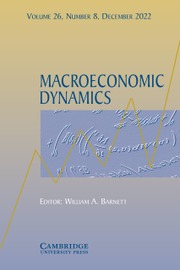No CrossRef data available.
Article contents
DATA REDUCTION BY THE HAAR FUNCTION: A CASE STUDY OF THE PHILLIPS CURVE
Published online by Cambridge University Press: 24 May 2021
Abstract
The unorthodox estimation procedure, which Phillips (1958) adopted in his original paper, is examined using the Haar wavelet filter. The application of the Haar wavelet transform to Phillips’ original data shows that Phillips’ six pairs of mean coordinates display a striking similarity with the Haar scaling coefficients that represent averages with a period greater than 16 years. This is consistent with Desai’s (1975) intuition on the interpretation of the Phillips Curve. We show that the choice of sorting observations by ascending values of the unemployment rate is crucial for reaching the goal of estimating the eye-catching nonlinear hyperbolic shape of the wage–unemployment relationship that would be otherwise linear. Interestingly, the Haar filter can account not only for the facts characterizing the Phillips’ relationship up to the early 1960s but also for two important facts mostly debated among policymakers: the downward shift of the Phillips Curve and its flattening over time.
Information
- Type
- Articles
- Information
- Copyright
- © Cambridge University Press 2021
Footnotes
A preliminary version of the paper has been presented at 2019 History of Economics Society Conference at Columbia University, New York, 20–23 June. The authors are grateful to Antonella Rancan and Jim Thomas for valuable inputs and comments on previous versions of this paper.

